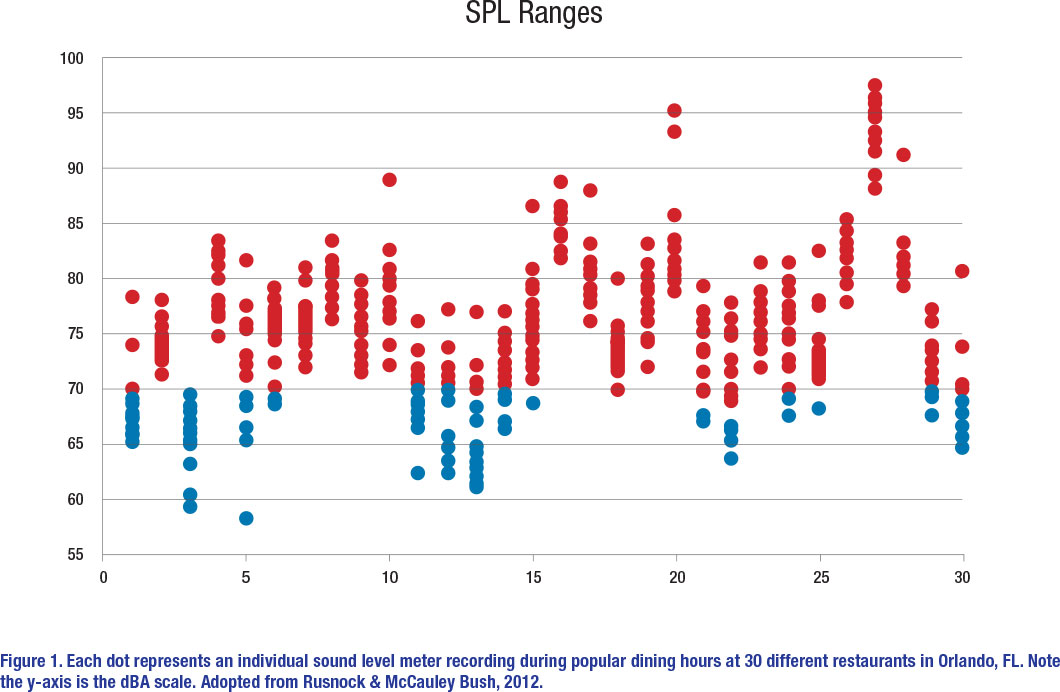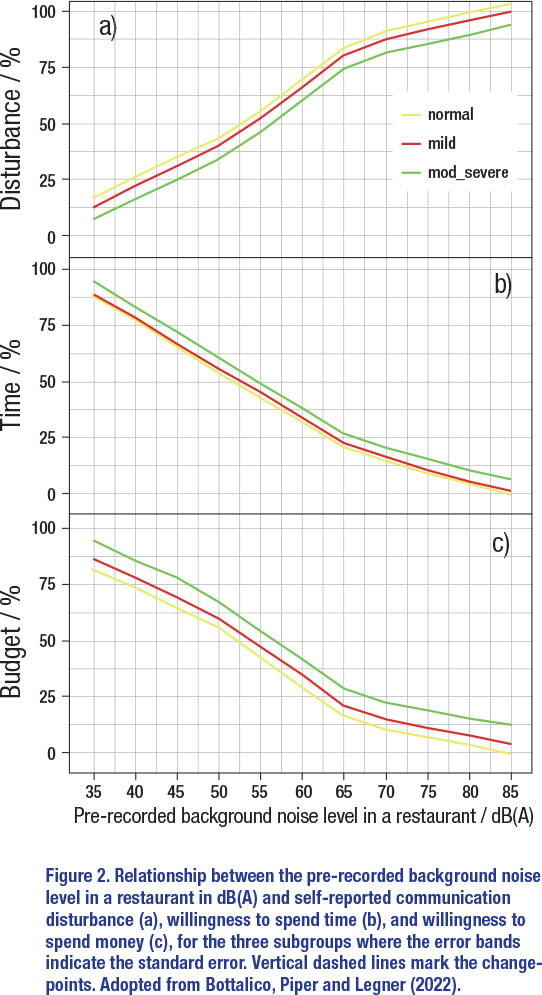
How Big a Problem is Background Noise?
Brian Taylor, Au.D.
To state the obvious, everyone struggles from time to time with communication in background noise. Even young healthy people with completely normal hearing find it incredibly challenging to converse in bust social situations. Our patients, of course, because of the consequences of both hearing loss and age find background noise to be even more problematic. How common and detrimental is the problem?
Data from two different studies illustrate just how often we experience high levels of noise when socially gathering outside the home, and additionally, just how challenging successfully communicating in these busy places, such as cafes, bars and restaurants tend to be.
What’s the deal with all that noise?
Thirty popular restaurants in Orlando, Florida had their sound levels measured. Equipped with a sound level meter, researchers took 10 to 15 measures during either lunch or dinner times when the restaurants were at least one-half full of diners. The results of these sound level measures are shown in Figure 1.

The x-axis in Figure 1 represents the 30 restaurants, while the y-axis represents the A-weighted decibel level of the sound level meter recordings. Note that for each restaurant there were between 10 and 15 recordings made, each recording is represented by a dot in Figure 1. Although there is considerable variability in intensity levels across the 30 restaurants, approximately 75% of the recordings captured noise levels greater than 70 dBA. Notice the red dots at or above 70 dB A. About two-thirds of indide social situations are above that level. Recall from your hearing science course (yes, that might have been a long time ago) that when the noise level is about 70 dB SPL or higher, the signal to noise ratio (SNR) tends to be 0 dB or worse.
Now, consider that persons with normal hearing need a SNR of about +5 dB to converse with relative ease with the person across the table and that many persons with hearing loss need a SNR of +10 or greater to accomplish the same task, and you realize most social gatherings are highly problematic for most of our patients. Finally, the struggles in noise illustrated in Figure 1 should remind us that a primary task of any pair of well-fitted hearing aids is to provide aggressive SNR improvements in these commonly encountered adverse listening situations — devices that are unlikely to be purchased over-the-counter.
Serenity Now!
 Figure 1 illustrates the high intensity levels experienced in crowded social gatherings. Perhaps an even more consequential problem, is the listener’s reaction during these busy occasions. Bottalico, Piper and Legner (2022) surveyed 31 older adults on their reaction to background noise. Specifically, they divided these 31 older adults into three groups, striated by degree of hearing loss. They evaluated their perception of disturbance in communication and their willingness to spend time and money in a restaurant, as a function of the varying levels of background noise.
Figure 1 illustrates the high intensity levels experienced in crowded social gatherings. Perhaps an even more consequential problem, is the listener’s reaction during these busy occasions. Bottalico, Piper and Legner (2022) surveyed 31 older adults on their reaction to background noise. Specifically, they divided these 31 older adults into three groups, striated by degree of hearing loss. They evaluated their perception of disturbance in communication and their willingness to spend time and money in a restaurant, as a function of the varying levels of background noise.
Their results indicated that background noise levels lower than 50 dBA enable older adults to minimize their vocal effort and to maximize their understanding of conversations, even for those with moderate to severe hearing loss. Of course, if the previously cited Orlando data in Figure 1 is characteristic of typical busy social gatherings, it is probably impossible to find a public indoor dining area where the noise level is 50 dBA.
Figure 2 shows the relationship between background noise level (x-axis) and respondents’ ratings along three variables: 1.) Disturbance in communication, 2.) Willingness to spend time, and 3.) Willingness to spend money (all on the y-axis). Across the three sub-groups, we can draw the following conclusions when noise levels exceed 65 dBA: 1.) Disturbance: On a 0 to 100 scale, with 100 being a very high rate of disturbance, an average rating of 75% was achieved, 2.) Willingness to spend time: With 100% being “a long time,” participants were willing to spend 25% or less of their allotted time when noise exceeded this level, and 3.) Willingness to spend money: Participants only were willing to spend 25% or less of their allotted dining budget when noise levels exceeded this level. Given the intensity levels of restaurants during popular dining times, not only is communication seriously compromised but older adults, regardless of degree of hearing, do not want to spend much time or money on them.
Given that virtually every indoor social gathering exceeds 65 dBA (see Figure 1) and that when the noise level reaches or exceeds about 65 dBA, the typical listener finds it bothersome, and moreover, is likely to be unwilling to spend much time or money there (see Figure 2), it is unsurprising that most persons with hearing loss are severely challenged in these situations — perhaps more than many audiologists realize.
How to apply these findings in clinic practice
- Provide all patients with detailed information about what they can do to improve communication in acoustically challenging social situations. All patients, regardless of treatment approach, need to be reminded of two overarching principles that improve the probability of successful communication in these places. Part of any holistic approach to counseling patients must include guidance on these two principles:
- Be Assertive: ask for clarification, ask for talkers to speak up and clearly enunciate, ask the talker to move closer to you, ask to be seated in the quietest part of the room.
- Be Aware: Avoid the noisiest parts of the room, get adequate rest prior to a busy social gathering to minimize problems with fatigue, rely on lip reading, facial expressions and knowledge of linguistic context to fill in the blanks of conversation that is masked by background noise and reverberation, learn how to use special functions on hearing aids in these situations (remote mic, streaming, dedicated program for noise, etc.) to optimize performance.
- Use the Quick SIN to measure each person’s unaided SNR loss. This provides the signal to noise ratio in which communication in noise begins to breakdown. Conducted under earphones during a routine hearing assessment the SNR loss of the individual provides valuable insight on the functional communication status of the individual. The higher the SNR loss, the more aggressive and sophisticated the noise reduction technology.
- Since most acoustic-challenged social situations have an SNR value of 0 or worse, be sure to recommend and fit hearing aids that have the ability to optimize performance in noise.
- Ensure that the primary path of sound is through the hearing aid, rather than the open ear. This is accomplished by fitting a more closed coupling system and verifying it is closed by gathering a real-ear occluding response (REOR) with your probe microphone equipment.
- Match a validated prescriptive target (NAL-NL2 or DSL v5) and verify with probe microphone measures to ensure audibility is optimized.
- Provide a manual override of automatic steering algorithms to ensure patients always have the ability to switch into a manual program that aggressively reduces background noise. ■
References
- Bottalico, P., Piper, R. N., & Legner, B. (2022). Lombard effect, intelligibility, ambient noise, and willingness to spend time and money in a restaurant amongst older adults. Scientific Reports, 12(1), 6549.
- Rusnock, C. & McCauley Bush, P. (2012) Case Study: An Evaluation of Restaurant Noise Levels and Contributing Factors. Journal of Occupational and Environmental Hygiene, 9:6, D108-D113.
